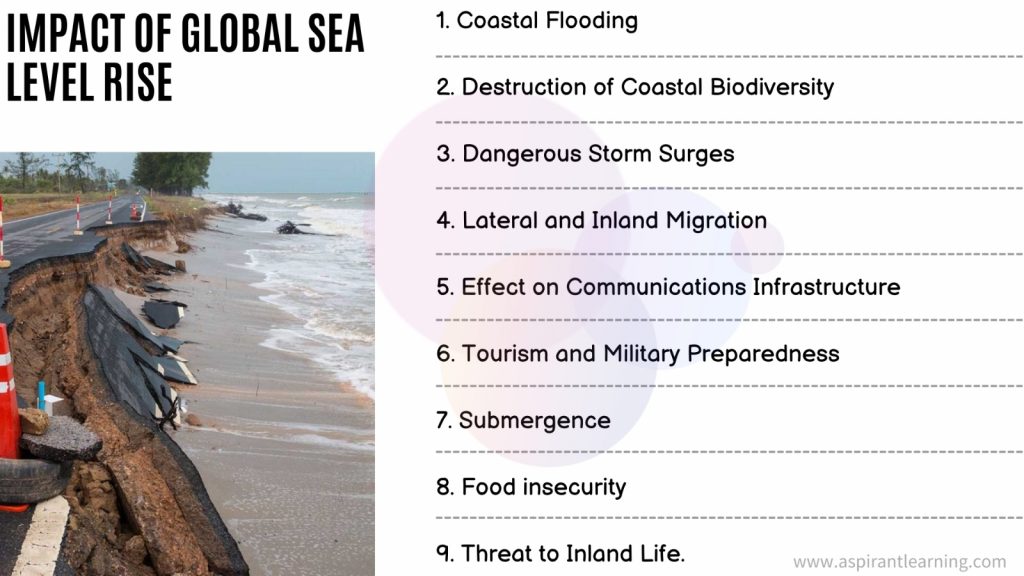News Highlights:
- The World Meteorological Organization (WMO) recently released the State of the Global Climate Report 2022.
- The World Meteorological Organization’s (WMO) new report states that the world’s sea level is rising at an unprecedented rate.

Highlights of the Report:
- Sea Level Rise:
- Global mean sea level (GMSL) continued to rise in 2022, reaching a new record high for the satellite altimeter record.
- For 2005-2019, total land ice loss from glaciers, Greenland, and Antarctica contributed 36% to the GMSL rise, and ocean warming contributed 55%.
- Ocean Heat:
- Ocean heat content reached a new record high in 2022.
- Around 90% of the energy trapped in the climate system by greenhouse gases goes into the ocean, somewhat ameliorating even higher temperature increases but posing risks to marine ecosystems.
- Ocean Acidification:
- CO2 reacts with seawater resulting in a pH decrease, referred to as ‘ocean acidification’, threatening organisms and ecosystem services.
- The IPCC Sixth Assessment Report concluded, “There is very high confidence that open ocean surface pH is now the lowest it has been for at least 26 [thousand years], and current rates of pH change are unprecedented since at least that time.
- Sea Ice:
- Sea ice in Antarctica dropped to 1.92 million km2 in February 2022, the lowest level on record, and almost 1 million km2 below the long-term (1991-2020) mean.
- Glaciers:
- Glaciers are losing a lot of ice, with a thickness change of over (-) 1.3 meters on average between October 2021 and October 2022, much larger than the average of the past decade.
- The European Alps saw record glacier melt due to a lack of winter snow, dust from the Sahara in March 2022, and heat waves from May to early September.
- Global mean temperature:
- The global mean temperature in 2022 was 1.15 °C above the 1850-1900 average.
- The years 2015 to 2022 were the eight warmest in the instrumental record back to 1850.
- This was despite three consecutive years of a cooling La Niña – such a “triple-dip” La Niña has happened only three times in the past 50 years.
- Greenhouse Gasses:
- Concentrations of the three primary GHG, Carbon dioxide, Methane, and Nitrous oxide, reached record highs in 2021.
- The annual increase in methane concentration from 2020 to 2021 was the highest on record.

Primary Factors For Sea Level Rise:
- Thermal Expansion:
- Water expands due to a temperature rise, which causes oceans to occupy more area and the sea level to rise.
- Water expands as it warms up. Warmer oceans simply take up more space, which accounts for around half of the sea level rise over the past 25 years.
- Global Warming:
- Global warming has grown due to the melting ice sheets in West Antarctica and Greenland. This process is harmed by freshwater seepage from the surface because it causes the ice streams to slide more quickly by acting as a lubricant.
- In other words, the ice sheets are pumped with clean, fresh water, which causes the ice to melt, weaken, and collapse into the sea, raising the sea level.
- Due to global warming, snowfall is softer, winters last longer, and springtime arrives earlier, causing ice not to recombine as frequently or in the same amount.
- Seasonal Change:
- An important factor in the intra-annual rise in sea level is the annual warming/cooling cycle, which occurs in each hemisphere and causes the seas to be warm and expand in the summer before cooling and contracting in the winter.
- Because of this, sea levels in both hemispheres are higher in the summer and early autumn and lower in the winter and early spring.
- Moreover, more water is held on land during the Northern Hemisphere winter than in the ocean, which lowers the global average sea level at this time of year.
Way Forward:
- Uncertainty about a metre or more sea level rise before 2100 is due to ignorance and the inability to run models accurately enough. It can be risky to ignore the unknowns.
- In addition to stronger coastal management, many actions must be taken as part of the adaptation to sea-level rise.
- Coastal populations should be warned and safeguarded during extreme weather conditions.
Pic Courtesy: Freepik
Content Source: The Hindu



